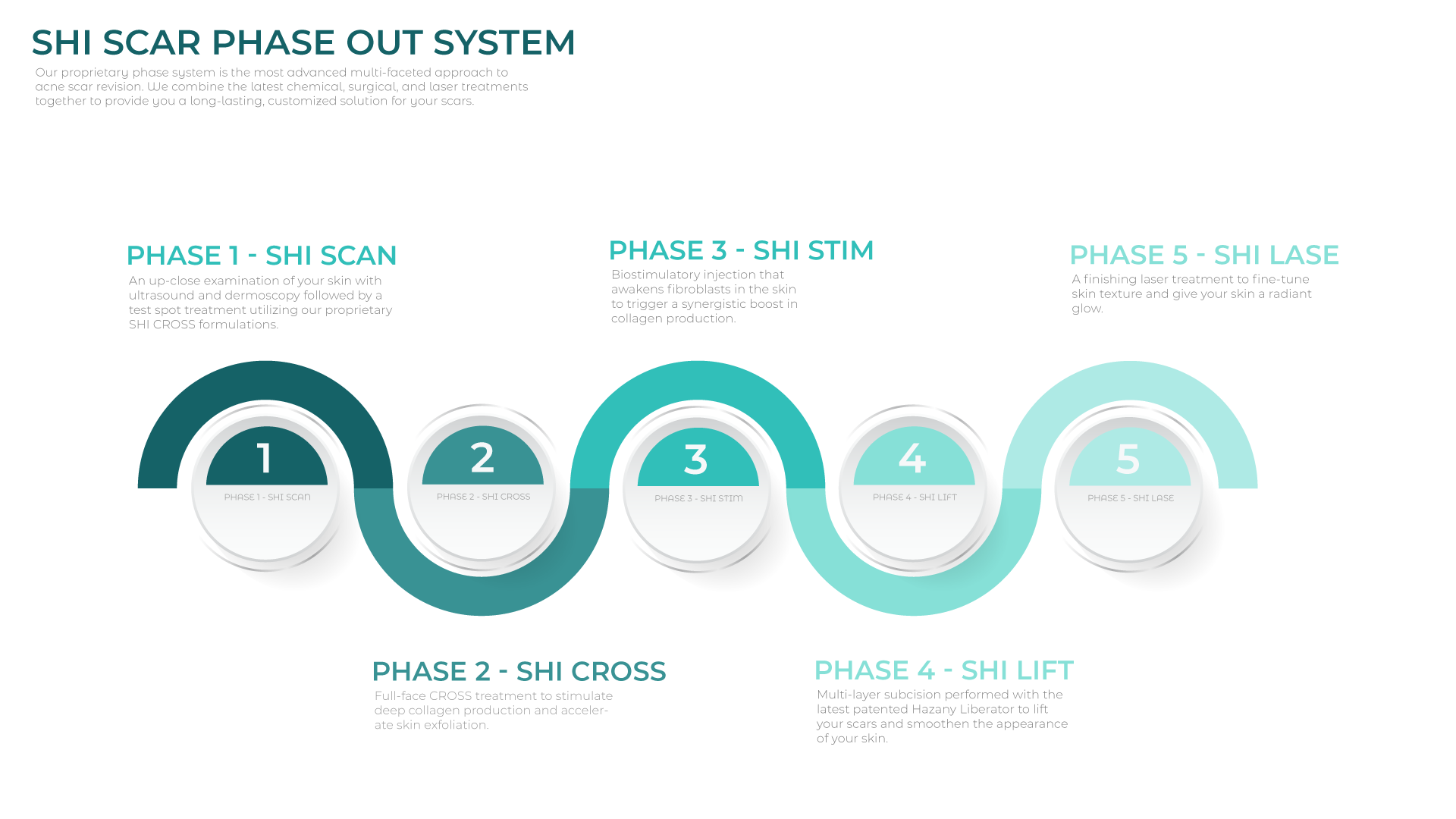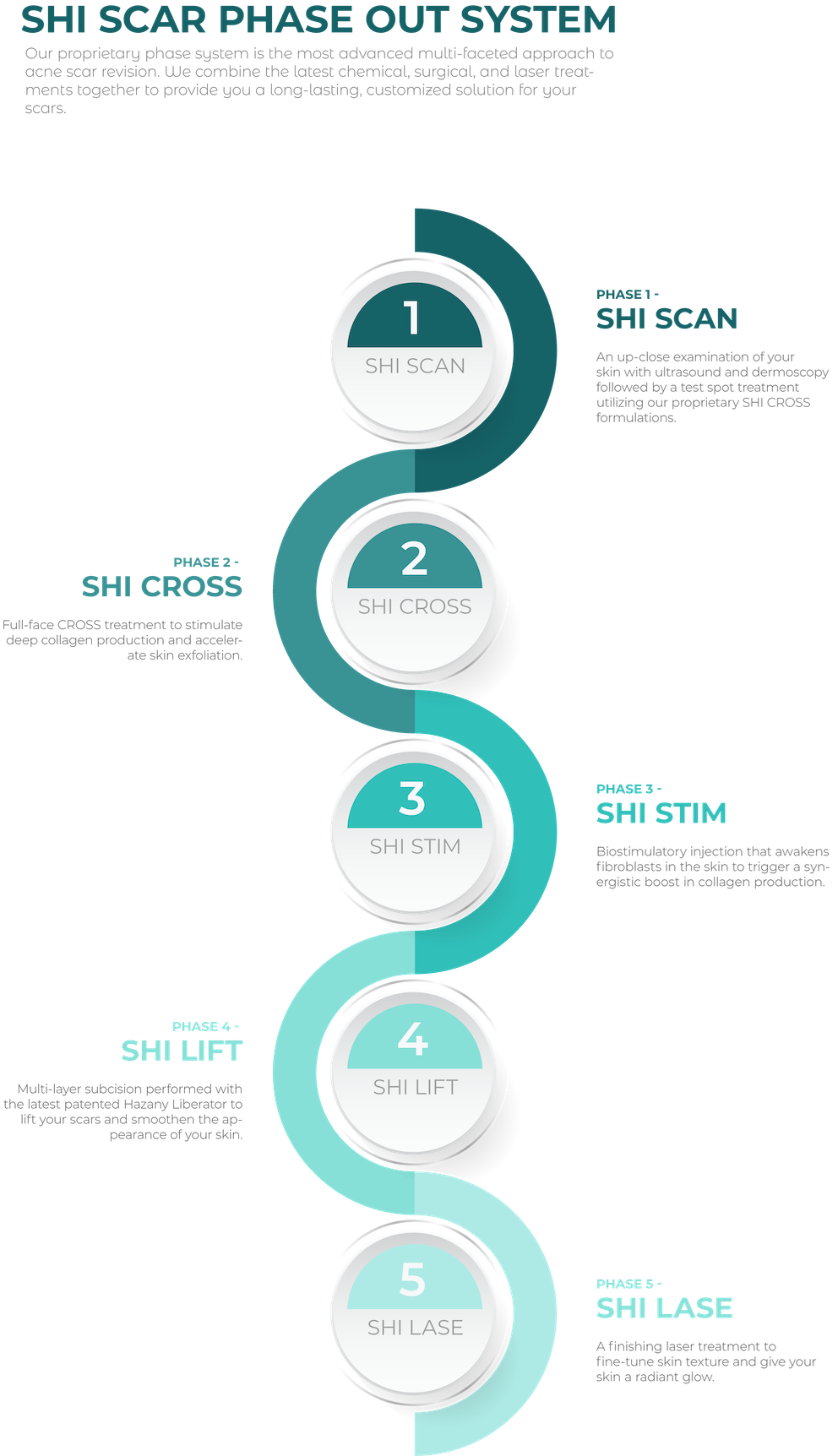Types of Acne Scars
Active Acne Scars
Active acne is an inflammatory skin condition that affects over 75% of adults and is particularly prevalent in teenagers undergoing hormonal changes within their bodies.
Active Acne most commonly appears on the parts of the skin that include the face, chest, neck, and back.
If it remains untreated it can cause permanent damage to your skin – this is commonly known as acne scarring.
Atrophic Scars
Atrophic scars refer to the pitted scar-like marks on a person’s skin. They originate when the skin fails to regenerate the tissue naturally, therefore leaving imbalanced scarring. This therapeutic challenge is a permanent result of acne vulgaris. The most common types of atrophic scars are:
- Ice pick
- Boxcar
- Rolling
What causes atrophic scars?
Atrophic scars result from the loss of collagen during the skin’s inflammatory healing process. The localized degradation of collagen and subcutaneous fat causes the affected area to dip below the level of healthy skin tissue. The type of atrophic scar that tends to form varies for each person. Here are the most common causes of atrophic scarring:
Icepick Scars
Ice pick scars are characterized as narrow indentations in the skin that usually result from severe cystic or papular acne burrowing deep in the skin. Among the three, ice pick scars are the most severe due to their tiny diameter and depth of penetration. They often appear on the forehead, cheekbones, and nose.
Among the three, ice pick scars are the most difficult acne scar treatment because of their narrowness and depth of penetration. In general, we have found that ice pick scars respond well to phenol CROSS, our frontline treatment method. However, patients with more severe ice pick scars may benefit more from punch excision, a process in which a small “cookie-cutter” tool is used to punch out the ice pick scar. In this manner, we ensure that the scar is removed in its entirety, as opposed to other treatments that merely treat the surface.
Boxcar Scars
Boxcar scars have sharp defined boundaries with more geometric indentations in the skin.Boxcar scars result from collagen depletion caused by acne breakouts, leaving a visible depression behind on the skin. Boxcars are typically shallower and wider than ice pick scars, and have vertical walls with an even, flat base.
Although boxcar scars can be treated with a variety of procedures, many of them, including laser, dermabrasion, and microneedling, work superficially and are ineffective for deeper scars.At our clinic, subcision, punch excision, and collagen stimulators are the most effective and long-lasting treatment options available. We will perform a thorough evaluation of each of your boxcar scars to customize your treatment plan.
Rolling Scars
Rolling scars develop when fibrous tissue tethers the epidermis to the underlying subcutaneous tissue, creating sloping and wave-like indentations in the skin. Rolling scars are shallow and soft depressions that become more noticeable when skin ages and loses its elasticity. Rolling scars can disappear over time but may require intervention depending on their severity.
Because rolling scars are the softest among the different scar types, they respond the best to subcision followed by collagen stimulation. We will perform a thorough evaluation of your rolling scars to assess their severity and depth to determine what layers will need to be subcised. It is important to manually sever the fibrotic tethers in multiple layers to completely remodel the skin. Any treatments that do not target these tethers will not solve the root cause of rolling scars.
Hypertrophic Scars
A hypertrophic scar is a thick raised scar developed on areas of high skin tension. It is an abnormal wound healing response that commonly occurs following diseases, burns, surgical incisions, and other forms of skin trauma. Although they aren’t life threatening, they can be a bit itchy and painful if left untreated.
Trauma to the skin can sometimes leave behind raised, rubbery scars called hypertrophic scars. Unlike atrophic acne scars, hypertrophic scars result from overproduction of collagen as opposed to the depletion of collagen. Like rolling scars, hypertrophic scars usually resolve over time but do require treatment depending on their severity. Hypertrophic scars have the following characteristics:
- Shiny luster
- Rubbery texture
- Raised
- Hairless
- Stays within border
Acne scars result from more severe forms of acne, notably cystic acne. People who pick or squeeze their acne can cause additional damage to their skin, which causes an even stronger inflammatory response. According to many studies, prolonged inflammation is linked to more extensive scarring. Therefore, it is important for patients to refrain from touching their blemishes to prevent further scarring down the line.
The three most common types of acne scars are ice pick, boxcar, and rolling scars. These scars have one thing in common: they all dip below the level of surrounding healthy skin due to the depletion of collagen. Because of this, with certain lighting, these dipped scars can cast noticeable shadows on the face and be aesthetically displeasing.
Icepick Scars
Boxcar Scars
Rolling Scars
How do your Prevent and Manage Acne Scars?
Acne scars can be a real pain, not just physically but also emotionally. They can make you feel self-conscious and cause you to lose confidence in your appearance. The good news is that there are things you can do to prevent and manage your acne scars. By following these tips, you can help prevent and reduce the appearance of acne scars.
- Keep your hands off your face: By touching your face, you can make acne scars worse. So, it’s important to keep your hands away from your face as much as possible.
- Get to know your skin: It’s important to understand your skin type so you can treat it accordingly. If you have oily skin, for example, you may need to wash your face more often than someone with dry skin.
- Get professional help: If home remedies haven’t been working, it may be time to see a dermatologist or healthcare professional to understand the overlying or underlying causes of your acne. We can help find a solution to your acne or recommend other treatments that may help improve the appearance of your scars.
What are Acne Scars?
Acne scars are a common consequence of acne. They can occur as the result of inflammation within the dermis, damage to the collagen fibers, or abnormal healing. Acne scars take on many different shapes and sizes, and their appearance can vary depending on their type.
Some common symptoms of acne scars include:
- Discoloration or redness in the affected area
- A raised or sunken appearance to the skin
- Thickening of the skin in the affected area
- A rough or pitted texture to the skin
Acne scars result from more severe forms of acne, notably cystic acne. People who pick or squeeze their acne can cause additional damage to their skin, which causes an even stronger inflammatory response. According to many studies, prolonged inflammation is linked to more extensive scarring. Therefore, it is important for patients to refrain from touching their blemishes to prevent further scarring down the line.
The three most common types of acne scars are ice pick, boxcar, and rolling scars. These scars have one thing in common: they all dip below the level of surrounding healthy skin due to the depletion of collagen. Because of this, with certain lighting, these dipped scars can cast noticeable shadows on the face and be aesthetically displeasing.
What is Acne?
How does acne form on the skin?
Acne is a common inflammatory skin condition resulting from trapped excess sebum, dead skin cells, and bacteria in the hair follicle. Acne breakouts can manifest in multiple forms, including blackheads, whiteheads, pus-filled pimples, and nodules.
Below are common symptoms of acne:
- Formation of cysts
- Crusting of skin bumps
- Small red bumps with yellow or white pus at the tip
- Papules or small red bumps
- Scarring on the skin
- Whiteheads and blackheads
- Itchy, red flakes on the skin
- Redness and soreness around the eruptions
Acne scar marks on your skin can be depressing. These acne scars often times remain visible even after your scar is long gone, which can be devastating for you and your mental health. Scars being visible on your skin can also affect your daily confidence.
Acne is caused among individuals due to a variety of reasons. It can be a change in location, hormonal conditions, climate change, dietary issues, and others. For many acne happen pretty frequently, leaving a lot of marks on their skin and a huge impact on their life. Scar Healing Institute is a reputed acne scar treatment clinic in California that helps you to get rid of your trouble and flaunt your confident self, without holding back.
Acne scars can also be caused by the inflammation of acne blemishes. When the acne pore swells, a breakdown occurs in the walls of the pore. During this breakdown, sometimes the content of the blemishes spill into the nearby tissues, causing deep scars.
Some interesting facts about acne scar marks:
- Around 80% of people between ages 11 and 30 are affected by acne scar marks.
- Shockingly, 85% of all people live their life with acne, which negatively affects their confidence.
- Acne outbreaks mostly occur on the face, shoulders, back, or chest.
- More than 40% of people experience acne by their mid-teens, and further into adulthood.
Acne scars are tough and stubborn. Only the top dermatologists in California can prevent these scars from leaving a negative mark on your life.
What are the causes of Acne Scars?
Acne scars are caused by a variety of factors, including genetics, lifestyle choices, and the type of acne you have. Here are some of the most common causes of acne scars:
- Genetics: If you have a family history of acne or other skin conditions, you may be more likely to develop acne scars.
- Lifestyle choices: Smoking, drinking alcohol, and using certain drugs can all increase your risk of developing acne scars.
- The type of acne you have: Some types of acne are more likely to lead to scarring than others. For example, deep cystic acne is more likely to cause scars than milder forms of acne.
Our Proprietary Acne Scar Treatments
Meet The Acne Scar Phase-Out System
Our proprietary phase system is specifically designed to attack acne scars from all angles: chemical reconstruction from the top-down and physical reconstruction from the bottom-up and from the side. We pride ourselves in our meticulous, personalized, and longitudinal approach to treating your scars.


Skin Acne Treatments & Procedures
While our proprietary phase system is highly customizable and flexible for patients, we recognize that patients may benefit from other procedures as well. Explore these treatment options below and see if they may be right for you!
How Can I Prevent Future Scarring from Happening?
Scarring is more common with poorly resolved cystic or nodular acne. In addition, it has an even greater likelihood of occurring when irritated or squeezed. Therefore, the first step to prevent scarring is to simply leave your acne lesions alone. It is difficult at first, but is worth the patience at the end.
At the same time, it is also important to ensure that your acne lesions do not become over-inflamed. The prolonged inflammation of your active acne will also increase scarring. Steroid injections, notably kenalog injections, are highly effective in quelling inflammation of your acne and thereby limit scarring.
How Do I Know What Type of Acne Scar I Have?
Our specialists at Scar Healing Institute can help identify your acne scar or scarring. We will work with you to create a plan that will help you achieve both mental and physical healing. Find out more!
If you are concerned that you may have acne scars, it is important to consult with a dermatologist or other skin care professional. Our dermatologists will be able to assess your skin and determine if you have any scarring.

